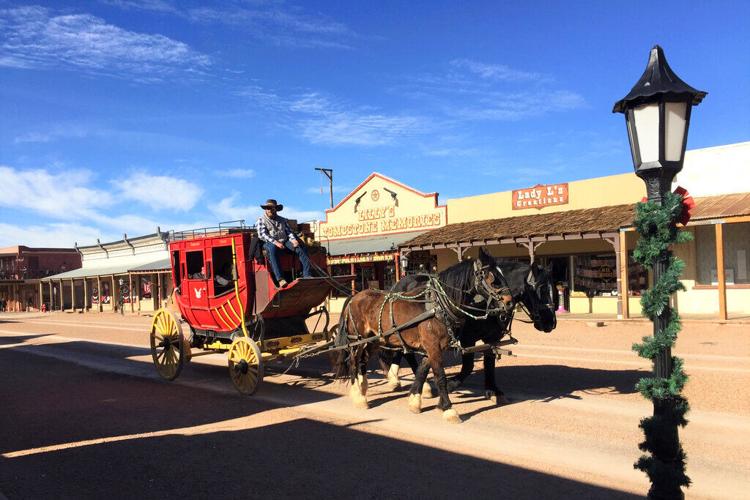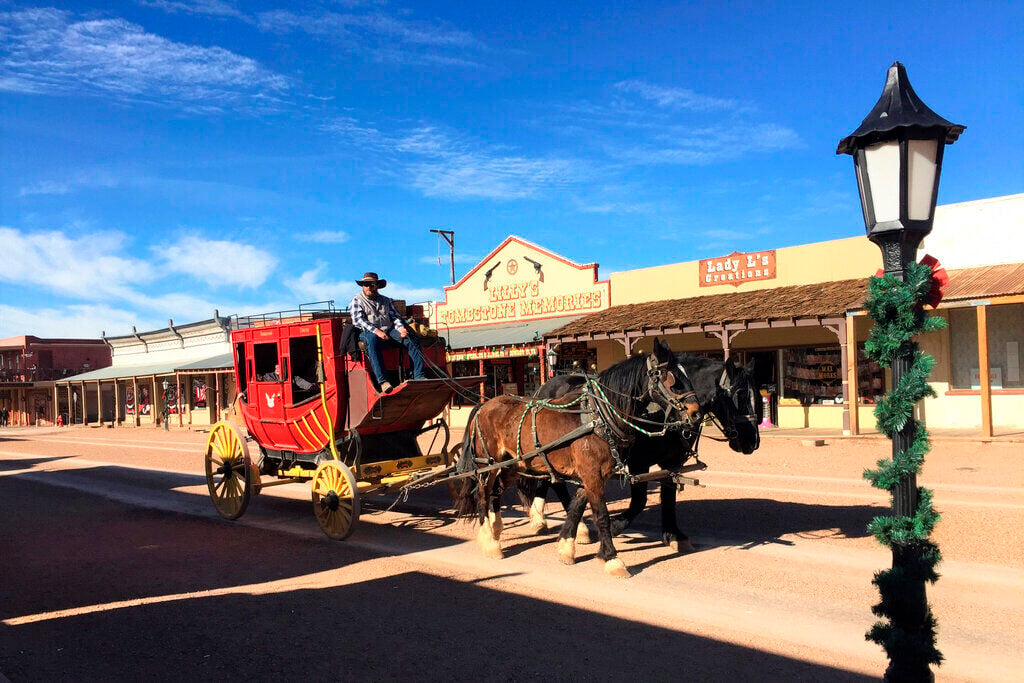As the driver careened the stagecoach down a barely perceptible trail, bouncing from rock to rock trying to avoid massive boulders lining the dusty highway, his face turned the color and consistency of sandpaper while his hair and eyebrows sported a coat of fine silt. If he had kept his mouth closed, he might have avoided the gritty taste of dirt tossed up by the coach’s horses but the man was a talker, regaling his passengers with tales of wanton cowboys who lay in wait to rob those daring to enter the territory.
The passengers listened with trepidation to the yarns that spewed from the man’s parched lips and he could barely hide his grin when he turned to see their horrified expressions. It was an unnerving 12-hour ride that the driver made daily, enjoying his reign of terror over tender-footed newcomers.
Arriving in Tombstone, the passengers plummeted out of the coach, a little unsteady on their feet after so many hours of sitting. Most were men and the majority had come to this desert wilderness seeking their fortunes in the silver mines that had opened a few years earlier. Just before the stage driver climbed back into his seat ready to head to the horse barn, out stepped a petite, attractive young woman.
Samantha Fallon nimbly jumped from the coach, made a futile attempt to brush the dust from her clothing, adjusted her feathery hat, grabbed her bag, and scanned the town.
This was not her first trip to Tombstone although records do not indicate when Samantha first arrived in Arizona, and she often gave conflicting dates concerning her whereabouts, her properties, and her husbands.
Born in Canada on Aug. 14, 1857, Samantha Elizabeth Steinhoff had shed one husband by the time she arrived on Tombstone’s streets. She may have left Mr. Fallon back in California, although no record has emerged of their marriage.
On Oct. 9, 1879, Samantha purchased a couple of lots on the corner of Tombstone’s Fremont and Fifth Street with the idea of building a boardinghouse. That December, she sold a portion of one of the lots, probably to obtain additional funds, but she still did not have enough money to finish the project. She started looking around for other sources of income.

A bronze statue of Wyatt Earp, by Tim Trask, stands on Freemont Street in Tombstone. The San Jose House that Samantha Fallon ran is on the corner of Fremont and Fifth Streets.
Still in her 20s, Samantha enjoyed the attention of many of the town’s eligible men, including Tombstone founder Ed Schieffelin. According to Samantha, Ed refused to marry her because she would not settle for just one man in her life. But he was willing to loan her what she needed to complete her boardinghouse.
By June 1880, Samantha’s San Jose House was up and running, one of the first establishments built in Tombstone to accommodate overnight visitors and long-term boarders. The 12-room hotel rarely had a vacant room.
The boardinghouse soon became known as one of the best meeting spots in town. Samantha often hosted fund-raising dinners for the Methodist church and held auctions that advertised for sale an assortment of items. Lace, corsets, socks, and hats were among the articles on the auction block.
Boasting that the son of former U.S. President Ulysses S. Grant, Ulysses S. “Buck” Grant II, sometimes roomed at her establishment, Samantha also housed her share of those who frequented the rougher side of Tombstone.
According to lawman Wyatt Earp, he “used to take my prisoners down to the San Jose room house. They had no jail in Tombstone at that time. That was before the county was divided. It was all Pima County and we had to take our prisoners to Tucson. In holding them in Tombstone I used to get a room in the San Jose and put a guard over them.”

U.S. Marshall Wyatt Earp posed for this portrait photo in 1881, during the general period he would have been taking his prisoners to Samantha Fallon's San Jose boarding house to be put into a room with a guard standing by because Tombstone had no jail at that time.
The bustle of activity at the San Jose House, along with Samantha’s proclivity for a lively social life, led many in town to assume her establishment might actually be a bordello with Samantha another of the local madams, but those rumors were never proven. And when she married local livery stable owner Zachary Hugh Taylor on Dec. 14, 1880, her standing in the community greatly improved.
“The wedding was very quiet,” according to the writeup in the Arizona Weekly Citizen, “only the most intimate friends of the couple being present. Mr. and Mrs. Taylor left immediately after the wedding in a four-in-hand private carriage for Benson, where they took the train for San Francisco and the East.”
In 1882, Samantha added a conservatory at the rear of the San Jose. According to the Tombstone Epitaph, “The flower beds, which are well stocked with choice plants, are tastefully arranged around the sides of the edifice, while the center is occupied by a low fountain — which, if the lady’s botanical efforts are crowned with success, will in the near future ‘gush forth in the midst of roses.’ This is one of the first experiments of the kind ever tried in Tombstone, and Mrs. Taylor deserves much credit for her enterprise and skill in projecting it.”
The exact date Samantha sold the San Jose House is speculative. She claimed she sold the property to a Mrs. Williams in 1909, but a Mrs. Gallen declared she bought the place in 1907. By then, Samantha had left Tombstone and eventually settled in Glendale, California, where she again established herself as a landlady by renting out rooms in her home. When she was hard up for money, she would rent her own bedroom and sleep on a cot in the kitchen.
Samantha died in Glendale March 16, 1931, and is buried at Forest Lawn Memorial Park. She supposedly left behind a manuscript describing her days in Tombstone, detailing the events she witnessed as well as the people she knew who made the town famous and infamous. The manuscript has not been located.
Today, one can still spend the night at the San Jose House. If a woman in a feathery hat passes by your window, give her a nod. She knows things about the town no one will ever uncover.
Along with some of history's more notorious gunslingers, like some of the Clanton gang, are those whose survivors could spin a tale on the headstone.







